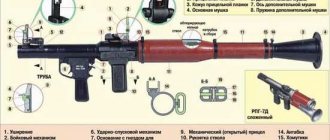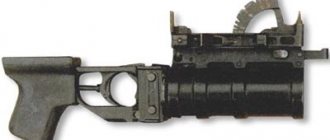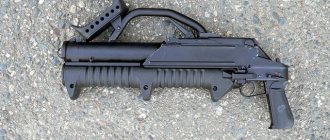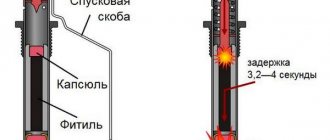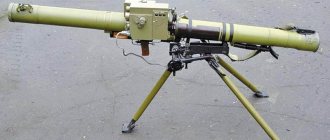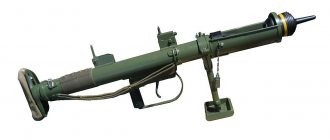Faustpatron 30 (top) and Panzerfaust 60 Faustpatron small
Faustpatron
(German Faustpatrone, from
Faust
- “fist”, here - “hand” and
Patrone
- “cartridge”) - the first single-action anti-tank grenade launcher.
It was also called “Faustpatron 1”, “Faustpatron small” (klein), “Faustpatron 30” or, later, “Panzerfaust 30” (here the index 30 is the effective firing range in meters). In the Red Army, the name “Faustpatron” was established as a collective designation for all German disposable anti-tank grenade launchers.
The Faustpatron was a lightweight dynamo-reactive (without recoil when fired) weapon. The grenade did not have a jet engine, but was fired from the barrel using a propellant charge, like a regular over-caliber grenade. To dampen recoil, the same principle was used as in recoilless rifles, namely dynamo-reactive: the barrel of the faustpatron was open on both sides, when the propellant charge was ignited, part of the gases pushed the grenade forward, and the other (larger) part escaped from the barrel back, forming a jet stream, which compensated for the recoil when fired. This led to a very short flight range of the grenade (up to 50 meters), and, as a consequence, to low efficiency.
The history of the creation of Faustpatron
In 1942, the Hasag company presented the Panzerfaust model to the German command (in Soviet literature it is better known as the Faustpatrone).
The first model of Heinrich Langweiler's Panzerfaust 30 Klein (small) grenade launcher had a total length of about a meter and weighed three kilograms. The grenade launcher consisted of a barrel and an over-caliber cumulative action grenade. The trunk was a pipe with smooth walls, 70 cm long and 3 cm in diameter; weight - 3.5 kg. Outside the barrel there was a percussion mechanism, and inside there was a propellant charge consisting of a powder mixture in a cardboard container. The grenade launcher pulled the trigger, the drummer applied the primer, igniting the powder charge. Due to the generated powder gases, the grenade flew out of the barrel. A second after the shot, the blades of the grenade opened to stabilize the flight. The relative weakness of the expelling charge forced the barrel to be raised at a significant elevation angle when firing at a distance of 50-75 meters. The maximum effect was achieved when firing at a distance of up to 30 meters: at an angle of 30 degrees, the grenade was capable of penetrating a 130-mm sheet of armor, which at that time guaranteed the destruction of any allied tank.
The ammunition used the cumulative Monroe principle: the high-explosive charge had a cone-shaped recess on the inside, covered with copper, with the wide part forward. When a shell hit the armor, the charge detonated at some distance from it, and the entire force of the explosion rushed forward. The charge burned through the copper cone at its apex, which in turn created the effect of a thin, directed stream of molten metal and hot gases hitting the armor at a speed of about 4000 m/s.
After a series of tests, the grenade launcher entered service with the Wehrmacht. In the fall of 1943, Langweiler received many complaints from the front, the essence of which was that the Klein grenade often ricocheted off the inclined armor of the Soviet T-34 tank. The designer decided to take the path of increasing the diameter of the cumulative grenade, and in the winter of 1943 the Panzerfaust 30M model appeared. Thanks to the enlarged cumulative crater, the armor penetration was 200 mm, but the firing range dropped to 40 meters.
In three months of 1943, German industry produced 1,300,000 Panzerfausts. constantly improved its grenade launcher. Already in September 1944, the Panzerfaust 60M was put into mass production, the firing range of which, thanks to an increase in the powder charge, increased to sixty meters.
In November of the same year, the Panzerfaust 100M appeared with an enhanced powder charge, which made it possible to fire at a distance of up to one hundred meters. The Faustpatron is a single-use RPG, but a shortage of metal forced the Wehrmacht command to oblige the rear supply units to collect used Faust barrels for recharging them at factories.
The scale of use of Panzerfaust is amazing - between October 1944 and April 1945, 5,600,000 “Faust cartridges” of all modifications were produced. The availability of so many disposable hand-held anti-tank grenade launchers (RPGs) in the final months of World War II allowed the untrained boys from the Volkssturm to inflict significant damage on allied tanks in urban battles.
An eyewitness, Yu. N. Polyakov, commander of the SU-76, tells:
Interestingly, the Allies did not hesitate to use captured RPGs. Since the Soviet army did not have such weapons, Russian soldiers regularly used captured grenade launchers to fight tanks, as well as in urban battles to suppress fortified enemy firing points.
From the speech of the commander of the 8th Guards Army, Colonel General V.I. Chuikov:
Development and application[ | ]
Faustpatron and Panzerfaust grenades Panzerfaust with a Volkssturmist (from the Hitler Youth) at a parade in the spring of 1945 in Berlin
Development began in 1942 on enlarged samples of the Faustpatron. As a result, the Panzerfaust was developed, which is a steel pipe with a caliber of 5 cm and a length of 1 meter. On top there was a sight and a trigger. Aiming was carried out by combining the sight and the upper edge of the warhead. Inside the pipe was a charge of black hunting powder in a cardboard cap. In the first versions of the Panzerfaust, the propelling charge was placed in the pipe by the soldier before firing. He also equipped the grenade with a separately supplied fuse. In front was a warhead with a caliber of 15 cm, weighing up to 3 kg and containing 0.8 kg of explosive. The explosive was a heterogeneous “alloy” of hexogen powder in TNT. It is impossible to obtain a real alloy of these substances - hexogen heated to the melting point decomposes, so hexogen powder was added to the TNT melt, stirred, and cooled. The stability of the mine's flight path was ensured by a flexible stabilizer made of four springy steel feathers. Before the shot, the stabilizer feathers were in the launch tube wound on a grenade shank rod carved from wood. When fired, due to the elasticity, the stabilizer feathers unfolded and provided the projectile with a more or less stable flight. At first glance, the simple design was distinguished by enviable functionality: the elongated nose cone not only gave the mine an aerodynamic shape, when it hit the armor, it crumpled, reducing the likelihood of a ricochet, giving time for the inertial fuse to work. The explosion of an “out of focus” shell caused a shallow notch to appear on the armor - “witch’s hickey” in front-line parlance [ source not specified 2905 days
]. On the pipe there was a red inscription in German: “Achtung! Feuerstrahl! (“Caution! Jet stream!”), warning soldiers not to stand behind the shooter. The effect of the jet stream on a person up to 3 meters behind the rear cut of the launch tube was fatal. According to the instructions, there should be 10 meters of free space behind the shooter. Like the Faustpatron, the Panzerfaust was disposable. The grenade penetrated steel armor plates up to 200 mm thick.
In urban combat conditions, the short distance allowed the weapon to be used with high (albeit later greatly exaggerated) effectiveness, which was especially noticeable in the battle for Berlin. The simplicity of the weapon made it possible to manufacture it in a besieged city and immediately transfer it to the defenders. The use of the panzerfaust did not require high training of the soldier.
Many Panzerfausts were delivered to Finland as anti-tank weapons against Soviet T-34 and IS-2 tanks.
Samples of captured “faustpatrons” (as soldiers of the allied forces mistakenly called both panzerfausts and faustpatrons) were used by the Soviet army, as well as by the industry of the USSR in the development of the first domestic RPG-2 grenade launcher.
Panzerschreck
In 1942, a sample of the American M1 Bazooka hand-held anti-tank grenade launcher (caliber 58 mm, weight 6 kg, length 138 cm, sighting range 200 meters) fell into the hands of German designers. The Wehrmacht Armament Directorate proposed a new technical specification to arms companies for the design of a Raketen-Panzerbuchse hand-held grenade launcher (rocket tank rifle) based on the captured Bazooka. Three months later, a prototype was ready, and after testing in September 1943, the German RPG Panzerschreck - “Thunderstorm of Tanks” - was adopted by the Wehrmacht. Such efficiency became possible due to the fact that German designers were already working on the design of a rocket-propelled grenade launcher.
The “Thunderstorm of Tanks” was an open, smooth-walled pipe 170 cm long. Inside the pipe there were three guides for a missile. For aiming and carrying, a shoulder rest and a handle for holding the RPG were used. Loading was carried out through the tail part of the pipe. To fire, the grenade launcher aimed the Panzerschreck at the target using a simplified sighting device that consisted of two metal rings. After pressing the trigger, the rod inserted a small magnetic rod into an induction coil (as in piezo lighters), resulting in the generation of an electric current, which, passing through the wiring to the rear of the launch tube, initiated the ignition of the projectile's powder motor.
The design of the “Panzerschreck” (official name 8.8 cm Raketenpanzerbuechse-43 - “88-mm rocket anti-tank gun of the 1943 model”) turned out to be more successful and had several advantages compared to its American counterpart:
The Tank Thunder had a caliber of 88 mm, and the American RPG had a caliber of 60 mm. Thanks to the increase in caliber, the weight of the ammunition doubled, and, consequently, the armor-piercing power increased. The shaped charge penetrated homogeneous armor up to 150 mm thick, which guaranteed the destruction of any Soviet tank (the American improved version of the Bazooka M6A1 penetrated armor up to 90 mm).
An induction current generator was used as a trigger mechanism. The Bazooka used a battery that was quite difficult to use and lost its charge at low temperatures.
Due to the simplicity of its design, the Panzerschrek provided a high rate of fire - up to ten rounds per minute (for the Bazooka - 3-4).
The Panzerschreck projectile consisted of two parts: a combat part with a shaped charge and a reactive part. To use RPGs in different climatic zones, German designers created an “arctic” and “tropical” modification of the grenade.
To stabilize the trajectory of the projectile, a second after the shot, a ring of thin metal was thrown out at the tail section. After the projectile left the launch tube, the gunpowder charge continued to burn for another two meters (for this, the German soldiers called the “Panzerschreck” Ofenrohr, chimney). To protect himself from burns when firing, the grenade launcher had to wear a gas mask without a filter and put on thick clothing. This drawback was eliminated in a later modification of the RPG, on which a protective screen with an aiming window was installed, which, however, increased the weight to eleven kg.
Thanks to its low cost (70 Reichsmarks - comparable to the price of a Mauser 98 rifle), as well as its simple design, more than 300,000 copies of the Panzerschrek were produced from 1943 to 1945. Overall, despite its shortcomings, the Tank Thunder became one of the most successful and effective weapons of the Second World War. Large dimensions and weight hindered the grenade launcher's actions and did not allow him to quickly change his firing position, and this quality is priceless in battle. Also, when firing, it was necessary to make sure that, for example, there was no wall behind the RPG gunner. This limited the use of the Panzerschrek in urban environments.
An eyewitness, V. B. Vostrov, commander of the SU-85, tells:
It was German RPGs that became the progenitors of modern “tank killers.” The first Soviet RPG-2 grenade launcher was put into service in 1949 and repeated the Panzerfaust design.
Material from the site topwar.ru
Anti-tank rifle "PIAT"
Another interesting design of a melee anti-tank weapon was the English anti-tank rifle, designed to fire 88-mm cumulative grenades. The gun consisted of a pipe and a tray welded to it. The pipe housed a bolt with a rigidly fixed firing pin and a return spring. A trigger box, a sighting device, a shoulder rest with a rubber shock absorber and, if necessary, a bipod were attached to the pipe.
The anti-tank grenade consisted of a warhead with a shaped charge and a fuse and a tail section with an expelling cartridge and tail.
To fire the first shot, the bolt was cocked manually and cocked. A grenade was placed in the tray, while closing the pipe channel. When the trigger lever was pressed, the bolt, under the action of a powerful recoil spring, began to move forward, its front part entered the channel of the grenade's tail, and the firing pin broke the primer of the expelling cartridge. The primer was punctured even before the bolt reached its extreme forward position (i.e., at the bolt rollout). The ignited expelling charge threw the grenade forward and the bolt back, putting it into combat cocking. A massive bolt, a powerful recoil spring and ignition of the expelling charge at the bolt rollout significantly reduced the recoil of the gun when fired.
| MAIN PERFORMANCE CHARACTERISTICS OF ANTI-TANK RIFLE “PIAT” | |
| Ammunition used | Grenade with a cumulative caliber warhead and a powder expelling charge |
| Starting device | Retractable, reusable |
| Barrel and grenade caliber, mm | 88 |
| Weight of PTR, kg | 15,75 |
| Grenade weight, kg | 1,18 |
| PTR length, mm | 973 |
| Sighting range, m | 90 (100 yards) |
| Initial speed of the grenade, m/s | 77 |
| Armor penetration, mm | up to 120 |
As already noted, the American and German Bazooka and Ofenror anti-tank guns and Faustpatron disposable grenade launchers marked the beginning of the widespread use of such close-combat anti-tank vehicles in the armies of many countries.
Options[ | ]
| Option | Weapon weight, kg | Mass of propellant charge, g | Head caliber, mm | Maximum grenade speed, m/s | Effective firing range, m | Armor penetration, mm |
| Faustpatron 30 | 2,7-3,2 | 70 | 100 | 28 | 30 | 140 |
| Panzerfaust 30 | 6,9 | 95-100 | 149 | 30 | 30 | 200 |
| Panzerfaust 60 | 8,5 | 120—134 | 149 | 45 | 60 | 200 |
| Panzerfaust 100 | 9,4 | 190—200 | 149 | 60 | 100 | 200 |
| Panzerfaust 150 | 6,5 | 100 | 106 | 85 | 150 | 280—320 |
Panzerfaust 30[ | ]
Finnish soldiers with Panzerfausts at the Battle of Tali-Ihantala.
Photo from the archives of the Finnish Defense Forces (SA-kuva) Use of weapons by Faustians The very first version of the weapon was the Panzerfaust 30, a pilot batch of which was produced in August 1943. The index 30 in the weapon designation refers to the nominal effective firing range in meters. The weight of the fully assembled weapon was 5.1 kg. According to some sources, the first use on the Eastern Front can be dated back to November 1943.
Panzerfaust 60[ | ]
This is the most common modification, production of which began in August 1944. The firing distance was increased to 60 meters, for which the diameter of the launch tube was increased from 44 to 50 mm, and the mass of the propellant charge was increased to 134 g. The firing mechanism was also improved. The weight of the weapon increased to 6.1 kg.
Panzerfaust 100[ | ]
This is the latest modification of the weapon to enter service with the troops since November 1944. The nominal firing range has been increased to 150 meters. The pipe diameter was again increased to 60 mm. The sight has holes with luminescent markings at 30, 60, 80 and 150 meters.
Panzerfaust 150 and 250[ | ]
"Panzerfaust 150" was released in a limited series at the very end of the war. The changes affected the warhead, and the charge was divided into two parts, which increased the speed of the grenade to 85 m/s and its penetration ability. The launch tube could be reused up to ten times.
The Panzerfaust 250 was planned for release in September 1945, but development was not completed.
Many modifications to the Panzerfaust were also made.
With anti-personnel missile[ | ]
One of the projects allowed it to be used as an anti-personnel weapon: the kit included a small missile, Kleinrakete zur Infanteriebekampfung ("small missile to destroy infantry"), warhead length 245 mm, diameter 76 mm. Several samples of this design were made, tests of which showed that the range was the same as that of rifle grenades.
With increased fragmentation effect[ | ]
At the end of 1944, the Panzerfaust 150 used ammunition with “shrapnel rings” (Splitterringe), which were notched like hand grenades to increase the fragmentation effect. Such a grenade simultaneously hit both the tank and enemy infantry, often located on the armor.
"Shrapnel Fist"[ | ]
Another development was the Schrappnellfaust ("shrapnel fist"), which, unlike the Panzerfaust, was reloadable, also designed to destroy infantry. The Shrapnel Fist weighed 8 kg and had a maximum range of 400 meters.
"Improved Armored Fist"[ | ]
In January 1945, a new warhead called Verbesserte Panzerfaust ("improved armored fist") was developed for the Panzerfaust. This modification had a pipe diameter of 160 mm with a variable detonation distance. There is no data on the use of this option by the Wehrmacht.
With a charge simplified to manufacture[ | ]
In February 1945, a shaped explosive charge called "nipolite" was developed. The production of such a charge was significantly simplified, because it did not require a metal case; the warhead could be turned directly on a lathe. Production of this modification of the Panzerfaust was not started due to the end of the war.
During the Cold War, the Bundeswehr used a completely new rocket-propelled grenade launcher called the Panzerfaust 3.
Serdyuk's grenade. Anti-tank grenade launcher PG-6
In the USSR, work on the creation of anti-tank weapons with cumulative ammunition began to be actively carried out in the 40s, although research in this direction was carried out at the Artillery Academy back in the 30s. Engineer of the Research Institute NII-6 M.Ya. Vasiliev in 1941 calculated the basic parameters for the design of cumulative projectiles. In the same year, the Red Army adopted an anti-tank rifle grenade with a cumulative warhead, VPGS-41, designed by Serdyuk, developed in the design bureau of the People's Commissariat of the Coal Industry of the USSR. The over-caliber ramrod grenade was fired using a blank cartridge from a conventional 7.62 mm rifle. At the beginning of the war, the Serdyuk grenade was produced in large quantities and was widely used against armored targets. However, in 1942 it was withdrawn from production and service due to frequent cases of premature grenade explosions at the moment of firing, leading to the death of soldiers.
In 1944, a group of designers from the Special Technology Bureau NII-6 developed an anti-tank grenade launcher. This grenade launcher was fired with RPG-6 anti-tank hand grenades or 50-mm fragmentation mines fired from a special pallet using an expelling charge. The firing range of the RPG-6 grenade reached 150 meters. By the beginning of 1945, an experimental batch of grenade launchers was manufactured for military testing. Later, due to the end of the war, work on this system was stopped.
After the capture of the first samples of German “Faustpatrons” at the front, the USSR began urgent work to study them and develop domestic designs of anti-tank grenade launchers with cumulative grenades.
Materials from the encyclopedia A.A. Lovi, V.V. Korenkov, V.M. Bazilevich, V.V. Korablin DOMESTIC ANTI-TANK GRENADE LAUNCH COMPLEXES
"Panzerfaust-1" and "Panzerfaust-2"
In Germany in 1943, disposable anti-tank grenade launchers “-1” and “Panzerfaust-2” were adopted and became widespread (these grenade launchers also had another, perhaps more common name - “Faustpatron”). “Panzerfaust” (German) can be translated as an iron fist, or anti-tank fist, and “Faustpatrone” (German) is a fist-shaped cartridge. Both grenade launchers had a similar fundamental design and differed only in the design and dimensions of the warhead and launcher.
The grenades of both grenade launchers had a cumulative warhead, a stabilizer with four spring blades and a starting powder charge. The warhead of a 150 mm (Panzerfaust-1) or 100 mm (Panzerfaust 2) grenade was located outside the barrel. Ammunition of this type is called over-caliber. The grenade had an inertial bottom fuse. The launching device was a smooth 44 mm caliber barrel made of a seamless steel pipe, into which a grenade with a powder expelling charge in a cardboard case was placed at the factory; The stabilizer blades were in the folded state. In this position, the grenade was rigidly fixed in the barrel and securely held in it during transportation, carrying, and aiming at various angles of elevation and declination. A hammer mechanism and a folding sighting bar were attached to the top of the barrel.
To fire, the barrel was grasped with both hands and pressed against the right side so that the gases flowing back did not hit the grenade launcher. Aiming was carried out through a figured slot in the sighting bar. The front sight was the top edge of the grenade shell. When the trigger mechanism was pressed, a beam of fire from the igniter primer was transmitted to the expelling charge, which, when ignited, pushed the grenade out of the barrel at low speed, since most of the gases flowed freely back from the barrel, balancing the recoil. The firing range did not exceed 30 m. Unlike the Bazooka, the Faustpatron grenades did not have a jet engine. This simplified the entire system, but significantly reduced the firing range. Despite this, “Faustpatrons”, due to the over-caliber warhead with a powerful cumulative charge, turned out to be an effective means of destroying tanks. "Faustpatron" can be considered the ancestor of modern disposable hand-held anti-tank grenade launchers.
| MAIN PERFORMANCE CHARACTERISTICS OF PANZERFAUST GRENADE LAUNCHERS | ||
| Panzerfaust-1 | Panzerfaust-2 | |
| Ammunition used | Shots with over-caliber cumulative grenade and starting powder charge | |
| Starting device | Recoilless, single use | |
| Barrel caliber, mm | 44 | 44 |
| Grenade warhead caliber, mm | 150 | 100 |
| Weight of the grenade launcher in firing position, kg | 5,35 | 3,25 |
| Length of the grenade launcher in firing position, mm | 1048 | 1010 |
| Grenade weight, kg | 2,8 | 1,65 |
| Mass of shaped charge, kg | 1,66 | 0,74 |
| Firing range, m | 30 | 30 |
| Armor penetration, mm | 200 | 140 |
Comparative characteristics
| General information and comparative tactical and technical characteristics of anti-aircraft grenade launchers | ||||
| Name | Luftfaust-A | Luftfaust-B | Fliegerfaust | Ear |
| Manufacturer | Hugo Schneider AG | KBM, OKB-61 | ||
| Project start date | July 1944 | September 1944 | February 1945 | June 1966 |
| Completion date | September 1944 | February 1945 | May 1945 | May 1968 |
| Number of trunks | four | nine | six | seven |
| Barrel block (configuration) | ||||
| Grenade launcher weight, g | 6500 | 9200 | ||
| Grenade launcher length, mm | 1000 | 1500 | 1500 | |
| Barrel caliber, mm | 26 | |||
| Ammunition | 2 cm BrsprGr | 2 cm R.SprGr | 3 cm M-Gesch. | NRS-30 |
| 2 cm L/Spur W | ||||
| Fuse | non-contact AZ 48, AZ 50A, AZ 50B, AZ 1528 or instantaneous contact AZ 1505 | |||
| Ammunition weight, g | 220 | 330 | 642 | |
| Mass of bursting charge, g | 19 | 15 | 75 | |
| Diameter and length of ammunition, mm | 26 × 231 | 21 × 228 | ||
| Diameter and length of the rocket (projectile), mm | 39 × 138 | 19 × 82 | ||
| Initial speed of the rocket (projectile), m/s | 250 | 310 | 110 | |
| Marching speed of the rocket (projectile), m/s | 380 | 350 | 560 | |
| Maximum flight altitude of a rocket (projectile), m | 1000 | |||
| Maximum missile (projectile) flight range, m | 2000 | 2000 | ||
| Height reach, m | 350 | 500 | ||
| Effective firing altitude at air targets, m | 200 | 300 | ||
| Effective firing range against ground targets, m | ||||
| Volley | sequential, divided into two phases | one-time | ||
| Interval between phases, s | 0,6—0,8 | 0,1—0,2 | — | |
| Sequence of missiles (shells) landing | 2 and 2 | 5 and 4 | 3 and 3 | 7 at once |
Information sources
| ||||
"Armor Pliers"
A smaller copy of the Panzerfaust was the Panzerknacke (Armor Tongs) grenade launcher. They equipped saboteurs with it, and the Germans planned to eliminate the leaders of the countries of the anti-Hitler coalition with these weapons.
On a moonless September night in 1944, a German transport plane landed on a field in the Smolensk region. A motorcycle was rolled out of it along a retractable ramp, on which two passengers - a man and a woman in the uniform of Soviet officers - left the landing site, driving towards Moscow. At dawn they were stopped to check the documents, which turned out to be in order.
But the NKVD officer drew attention to the officer’s clean uniform - after all, there had been heavy rain the night before. The suspicious couple was detained and, after checking, handed over to SMERSH
These were saboteurs Politov (aka Tavrin) and Shilova, whose training was carried out by Otto Skorzeny himself. In addition to a set of false documents, the “major” even had fake clippings from the newspapers “Pravda” and “Izvestia” with essays about heroic deeds, decrees on awards and a portrait of Major Tavrin. But the most interesting thing was in Shilova’s suitcase: a compact magnetic mine with a radio transmitter for remote detonation and a compact Panzerknakke rocket launcher.
The length of the “Armor Tongs” was 20 cm, and the launch tube had a diameter of 5 cm. A rocket was put on the tube, which had a range of thirty meters and penetrated armor 30 mm thick. The Panzerknakke was attached to the shooter's forearm using leather straps. In order to carry a grenade launcher secretly, Politov was sewn a leather coat with an extended right sleeve. The grenade was launched by pressing a button on the wrist of the left hand - the contacts closed, and the current from the battery hidden in the belt initiated the Panzerknakke fuse. This “miracle weapon” was intended to kill Stalin while traveling in an armored car.

